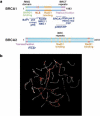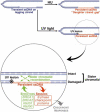In search of the tumour-suppressor functions of BRCA1 and BRCA2
- PMID: 11100717
- PMCID: PMC2981135
- DOI: 10.1038/35044000
In search of the tumour-suppressor functions of BRCA1 and BRCA2
Abstract
Hereditary breast and ovarian cancer syndromes can be caused by loss-of-function germline mutations in one of two tumour-suppressor genes, BRCA1 and BRCA2 (ref. 1). Each gene product interacts with recombination/DNA repair proteins in pathways that participate in preserving intact chromosome structure. However, it is unclear to what extent such functions specifically suppress breast and ovarian cancer. Here we analyse what is known of BRCA gene function and highlight some unanswered questions in the field.
Figures



References
-
- Welcsh PL, Owens KN, King MC. Insights into the functions of BRCA1 and BRCA2. Trends Genet. 2000;16:69–74. - PubMed
-
- Scully R, et al. Association of BRCA1 with Rad51 in mitotic and meiotic cells. Cell. 1997;88:265–275. - PubMed
-
- Sharan SK, et al. Embryonic lethality and radiation hypersensitivity mediated by Rad51 in mice lacking Brca2. Nature. 1997;386:804–810. - PubMed
-
- Chen J, et al. Stable interaction between the products of the BRCA1 and BRCA2 tumoursuppressor genes in mitotic and meiotic cells. Mol. Cell. 1998;2:317–328. - PubMed
-
- Scully R, et al. Dynamic changes of BRCA1 subnuclear location and phosphorylation state are initiated by DNA damage. Cell. 1997;90:425–435. - PubMed
MeSH terms
Substances
Grants and funding
LinkOut - more resources
Full Text Sources
Other Literature Sources
Miscellaneous

